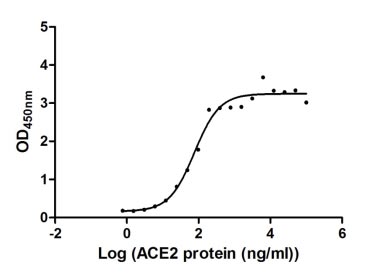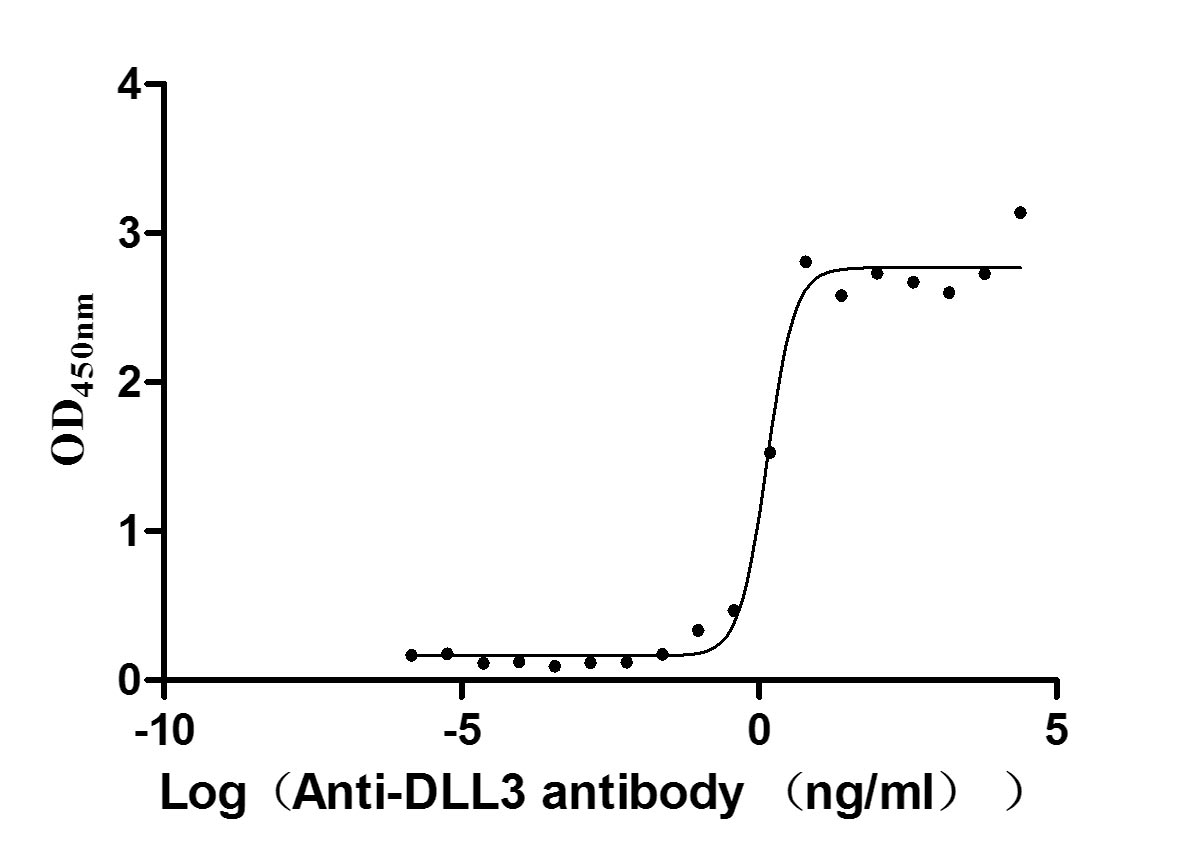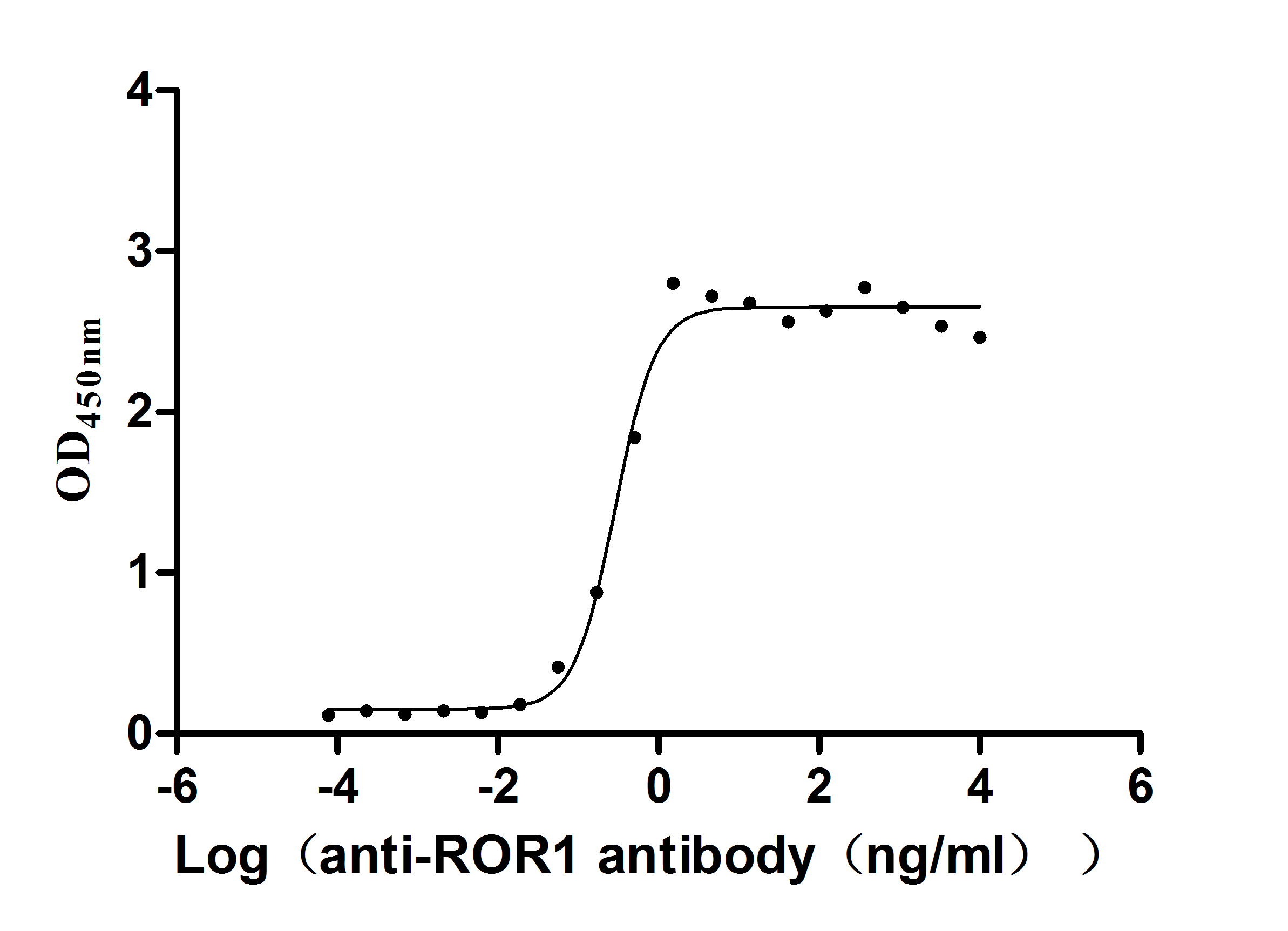Recombinant Mouse Acetylcholinesterase (Ache)
-
货号:CSB-YP001154MO
-
规格:
-
来源:Yeast
-
其他:
-
货号:CSB-EP001154MO
-
规格:
-
来源:E.coli
-
其他:
-
货号:CSB-EP001154MO-B
-
规格:
-
来源:E.coli
-
共轭:Avi-tag Biotinylated
E. coli biotin ligase (BirA) is highly specific in covalently attaching biotin to the 15 amino acid AviTag peptide. This recombinant protein was biotinylated in vivo by AviTag-BirA technology, which method is BriA catalyzes amide linkage between the biotin and the specific lysine of the AviTag.
-
其他:
-
货号:CSB-BP001154MO
-
规格:
-
来源:Baculovirus
-
其他:
-
货号:CSB-MP001154MO
-
规格:
-
来源:Mammalian cell
-
其他:
产品详情
-
纯度:>85% (SDS-PAGE)
-
基因名:Ache
-
Uniprot No.:
-
别名:Ache; Acetylcholinesterase; AChE; EC 3.1.1.7
-
种属:Mus musculus (Mouse)
-
蛋白长度:Full Length of Mature Protein
-
表达区域:32-614
-
氨基酸序列EGREDPQLL VRVRGGQLRG IRLKAPGGPV SAFLGIPFAE PPVGSRRFMP PEPKRPWSGV LDATTFQNVC YQYVDTLYPG FEGTEMWNPN RELSEDCLYL NVWTPYPRPA SPTPVLIWIY GGGFYSGAAS LDVYDGRFLA QVEGAVLVSM NYRVGTFGFL ALPGSREAPG NVGLLDQRLA LQWVQENIAA FGGDPMSVTL FGESAGAASV GMHILSLPSR SLFHRAVLQS GTPNGPWATV SAGEARRRAT LLARLVGCPP GGAGGNDTEL IACLRTRPAQ DLVDHEWHVL PQESIFRFSF VPVVDGDFLS DTPEALINTG DFQDLQVLVG VVKDEGSYFL VYGVPGFSKD NESLISRAQF LAGVRIGVPQ ASDLAAEAVV LHYTDWLHPE DPTHLRDAMS AVVGDHNVVC PVAQLAGRLA AQGARVYAYI FEHRASTLTW PLWMGVPHGY EIEFIFGLPL DPSLNYTTEE RIFAQRLMKY WTNFARTGDP NDPRDSKSPQ WPPYTTAAQQ YVSLNLKPLE VRRGLRAQTC AFWNRFLPKL LSATDTLDEA ERQWKAEFHR WSSYMVHWKN QFDHYSKQER CSDL
-
蛋白标签:Tag type will be determined during the manufacturing process.
The tag type will be determined during production process. If you have specified tag type, please tell us and we will develop the specified tag preferentially. -
产品提供形式:Lyophilized powder
Note: We will preferentially ship the format that we have in stock, however, if you have any special requirement for the format, please remark your requirement when placing the order, we will prepare according to your demand. -
复溶:We recommend that this vial be briefly centrifuged prior to opening to bring the contents to the bottom. Please reconstitute protein in deionized sterile water to a concentration of 0.1-1.0 mg/mL.We recommend to add 5-50% of glycerol (final concentration) and aliquot for long-term storage at -20℃/-80℃. Our default final concentration of glycerol is 50%. Customers could use it as reference.
-
储存条件:Store at -20°C/-80°C upon receipt, aliquoting is necessary for mutiple use. Avoid repeated freeze-thaw cycles.
-
保质期:The shelf life is related to many factors, storage state, buffer ingredients, storage temperature and the stability of the protein itself.
Generally, the shelf life of liquid form is 6 months at -20°C/-80°C. The shelf life of lyophilized form is 12 months at -20°C/-80°C. -
货期:Delivery time may differ from different purchasing way or location, please kindly consult your local distributors for specific delivery time.Note: All of our proteins are default shipped with normal blue ice packs, if you request to ship with dry ice, please communicate with us in advance and extra fees will be charged.
-
注意事项:Repeated freezing and thawing is not recommended. Store working aliquots at 4°C for up to one week.
-
Datasheet :Please contact us to get it.
相关产品
靶点详情
-
功能:Terminates signal transduction at the neuromuscular junction by rapid hydrolysis of the acetylcholine released into the synaptic cleft.
-
基因功能参考文献:
- Results indicate that direct inhibition of acetylcholinesterase activity and up-regulation of m1 muscarinic acetylcholine receptor expression in the striatum might contribute to the beneficial effects of alpha-asarone on locomotor hyperactivity in Fmr1 knock out mice. PMID: 27316341
- Data show that 1-month of oral treatment with beta-asarone reduces AChE, Abeta42, APP and Beclin-1 levels and alleviates some behavioral impairments by inhibiting the autophagy via regulating the PI3K/Akt/mTOR pathway in APP/PS1 transgenic mice. The results further support the exploration of beta-asarone as a possible disease-modifying agent for the treatment of Alzheimer's disease. PMID: 27737765
- Results indicate that adult onset hypothyroidism caused significant memory impairment and increased fear/anxiety. Moreover, the activity of both isoforms of AChE was reduced in all brain regions examined in a brain region- and isoform-specific manner. PMID: 27317840
- Unusually high AChE activity may be an effect marker of exposure to ethanol. The relationship between AChE and apoptosis might represent a novel mechanism of ethanol-associated neuronal injury. PMID: 28427893
- Findings suggested the role of DNA methylation on acetylcholinesterase transcriptional regulation and provided insight in elucidating the DNA methylation-mediated regulatory mechanism on acetylcholinesterase expression during muscle differentiation. PMID: 27021952
- Nerolidol-loaded nanospheres reverse memory impairment and to prevent increased ROS and TBARS levels due to amelioration of Na(+), K(+)-ATPase and AChE activities and to activation of the antioxidant enzymes, respectively. PMID: 27807596
- the amounts of AChE activity, AChE catalytic subunit, structure subunit PRiMA and the amount of acetylcholine, in the brain were not, significantly, altered, suggesting the role of P2Y1R in neuron could have different function as that in muscle. PMID: 27378627
- In P2Y1R (-/-) mice, acetylcholinesterase expression in muscle was markedly decreased. The proline-rich membrane anchor subunit was reduced by 60 %; while the collagen tail subunit was reduced by 50 %. AChE molecular forms in the muscle were not changed. PMID: 26036470
- Our results are discussed in the context of AChE inhibitor therapy as used in dementia. PMID: 26506622
- Reduction of AChE levels in prion-infected heterozygous AChE knock-out mice leads to slightly but significantly prolonged incubation time. PMID: 25853328
- mRNA expressions of brain specific fatty acid protein 7 (fabp-7) and phospholipase A2 group IV (pla2g4) were significantly downregulated in AChE-deficient mice. PMID: 24573602
- In silico studies in probing the role of kinetic and structural effects of different drugs for the reactivation of tabun-inhibited AChE. PMID: 24312449
- AChE is regulated in two neuronal cell lines by APP in a manner independent of the generation of sAPPalpha, sAPPbeta, and AICD. PMID: 23897820
- Deficiency or inhibition of acetylcholinesterase can decrease apoptosis and protect dopaminergic neurons in the neurotoxin model of Parkinson's disease. PMID: 23201480
- Attribute stress-inducible cognitive impairments to cholinergic-mediated induction of miR-132 and consequently suppressed synaptic ACHE. PMID: 22246100
- assayed the relative activities of AChE and BChE in membrane fractions and culture medium of three different neuronal cell lines, namely the neuroblastoma cell lines SH-SY5Y and NB7 and the basal forebrain cell line SN56 PMID: 23047022
- Long-lasting stress-inducible changes in AChE's promoter choices, identify the chromatin changes that support this long-term transcriptional memory, and reveal HDAC4 as a mediator of these effects in the hippocampus. PMID: 23236169
- binding of AChE to laminin-1 alters AChE activity and leads to increased neurite growth in culture. A possible mechanism of the AChE effect on neurite outgrowth is proposed due to the interaction of AChE with laminin-1. PMID: 22570738
- The reduction of muscle end-plate AChE activity early during the onset of STZ-induced hyperglycemia may contribute to endplate pathology and subsequent muscle weakness during diabetes. PMID: 22739110
- Acetylcholinesterase is associated with apoptosis in beta cells and contributes to insulin-dependent diabetes mellitus pathogenesis PMID: 22236578
- Report effects of K074 and pralidoxime on antioxidant response and acetylcholinesterase reactivation in malathion-poisoned mice. PMID: 21723318
- Brain acetylcholinesterase activity in Dst(dt-J) mutants, revealed increases in the neostriatum, the habenula-interpeduncular pathway, the cholinergic pedunculopontine nucleus and its target structures. PMID: 21978551
- Dietary restriction regulates brain acetylcholinesterase in female mice as a function of age. PMID: 21870149
- PUM2 binds to AChE mRNA and regulates AChE expression translationally at the neuromuscular synapse. PMID: 21865157
- Electrophysiological and ultrastructural studies were performed on phrenic nerve-hemidiaphragm preparations isolated from wild-type and acetylcholinesterase (AChE) knockout (KO) mice. PMID: 21538119
- Results confirm the results of previous molecular dynamics simulations, expand the view and suggest the probable reasons for the overall conformational behavior of AChE omega loop. PMID: 20919754
- AChE activity is present both in the primary cleft and in the secondary folds, whereas BChE activity appears to be almost absent in the primary cleft and to be concentrated in subsynaptic folds. PMID: 20805581
- the function and localization of AChE in mammalian systems PMID: 20153304
- RNA expression profiles of the muscles of AChE knockout mice compared with those of the wild-type siblings PMID: 20381477
- AChE may be a pro-apoptotic factor and the inhibition of AChE reduces renal ischemia-reperfusion injury. PMID: 20054652
- these findings identify the AChE mRNA-targeting miR-132 as a functional regulator of the brain-to-body resolution of inflammation. PMID: 20005135
- neuronal hypersensitivity under stress involves neuritic replacement of acetylcholinesterase-S with acetylcholinesterase-R PMID: 11799248
- The effects of porphyrinogenic drugs on the brain cholinergic system (Ache, Bche, and Chrm1 levels in various regions of the brain) were examined to establish a mechanism for neurological syndrome displayed in acute porphyrias. PMID: 11929041
- regulation of ACHE expression in developing muscle cells PMID: 12140295
- Inhibitors of different structure induce distinguishing conformations in the omega loop. PMID: 12196517
- ligand interactions of the enzyme at the peripheral anionic site PMID: 12505979
- Interaction with RACKq and PKCbeta II correlates with intensified fear-induced conflict behavior PMID: 12509514
- an analysis of the active site and conformation PMID: 12665427
- fluctuations of the Omega loop residues are not tightly coupled and residues in the Omega loop exhibit distinctive conformational fluctuations and therefore are likely to contribute to transient gorge enlargements in the non-liganded enzyme. PMID: 12759360
- Acetylcholinesterase[AChE] histochemistry revealed an abnormal distribution of AChE-positive cells in several areas of the reeler brain, including cortices; the strongest labelling was observed in cerebellum and hippocampus when compared with controls PMID: 14535959
- primary role for stress-induced alternative splicing of the AChE gene to elevated contextual fear and synaptic plasticity, and the AChE-R splice variant has a major role in this process. PMID: 14581933
- Molecular modeling studies suggest that E2020 interacts with the active-site and the peripheral anionic site in AChE PMID: 14622273
- Data suggest that alternative promoter usage combined with alternative splicing may lead to stress-dependent combinatorial complexity of acetylcholinesterase mRNA transcripts and their protein products. PMID: 15123727
- Data describe up-regulation of acetylcholinesterase activity and compensatory down-regulation of M2 muscarinic receptors in the striatal caudate putamen and nucleus accumbens of mu-opioid receptor knockout mice. PMID: 15207914
- biophysical diffusion reaction rate calculations of wild-type and mutant mouse acetylcholinesterase PMID: 15345536
- AChE is involved in regulating cell-matrix interactions in bone PMID: 15454088
- Impaired formation of the inner retina in an AChE knockout mouse results in degeneration of all photoreceptors. PMID: 15579149
- HuR interacts with the AChE 3'-UTR to regulate posttranscriptionally the expression of AChE mRNA during myogenic differentiation PMID: 15878846
- structural studies of active center gorge of AChe PMID: 16259971
- neuromuscular system exhibits a remarkable plasticity and adaptive responses to the chronic absence of AChE activity that has important consequences for the functioning of the neuromuscular junction PMID: 16274683
显示更多
收起更多
-
亚细胞定位:Cell junction, synapse. Secreted. Cell membrane; Peripheral membrane protein.; [Isoform H]: Cell membrane; Lipid-anchor, GPI-anchor; Extracellular side.
-
蛋白家族:Type-B carboxylesterase/lipase family
-
组织特异性:Predominates in most expressing tissues except erythrocytes where a glycophospholipid-attached form of ACHE predominates.
-
数据库链接:
KEGG: mmu:11423
STRING: 10090.ENSMUSP00000024099
UniGene: Mm.255464
Most popular with customers
-
Recombinant Human Angiotensin-converting enzyme 2 (ACE2), partial (Active)
Express system: Mammalian cell
Species: Homo sapiens (Human)
-
Recombinant Human Delta-like protein 3 (DLL3), partial (Active)
Express system: Mammalian cell
Species: Homo sapiens (Human)
-
Express system: Mammalian cell
Species: Homo sapiens (Human)
-
Recombinant Human Trophoblast glycoprotein (TPBG), partial (Active)
Express system: Mammalian cell
Species: Homo sapiens (Human)
-
Recombinant Human Desmoglein-2 (DSG2), partial (Active)
Express system: Mammalian cell
Species: Homo sapiens (Human)
-
Recombinant Human Myosin regulatory light chain 12A (MYL12A) (Active)
Express system: E.coli
Species: Homo sapiens (Human)
-
Recombinant Human Cadherin-6(CDH6),partial (Active)
Express system: Mammalian cell
Species: Homo sapiens (Human)
-
Express system: Mammalian cell
Species: Homo sapiens (Human)




















